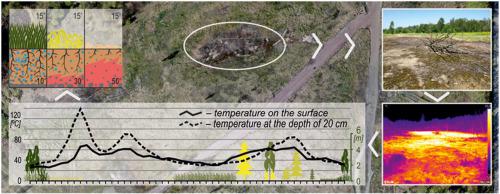Fire Safety Journal ( IF 3.4 ) Pub Date : 2021-01-25 , DOI: 10.1016/j.firesaf.2021.103287 Abramowicz Anna , Rahmonov Oimahmad , Chybiorz Ryszard , Ciesielczuk Justyna

|
The paper presents the impact of thermal processes on the dynamics of changes in vegetation and soil properties in the area of coal-waste dumps where self-heating and self-ignition processes occur. Vegetation analysis involved the determination of species composition, life forms, and synecological affiliation. The mosaic diversity of the granulometric composition of the stored material and dynamically changing soil temperature had an impact on the character of vegetation. A specific type of flora, with various ecological requirements, was formed. Hemicryptophytes and apophytes predominated, especially in thermally active zones. The distribution of the range of vegetation due to changes in soil thermics was examined during three periods within a selected transect, in which three types of surfaces with varying soil thermics and smoldering fire directions were distinguished. Temperatures ranged from 9.9 to 139 °C at a depth of 20 cm and, simultaneously, from 3.1 to 69.0 °C on the surface. Total organic carbon content in all samples ranged from 1.7 to 7.6 and, simultaneously, from 3.1 to 4.5% in the active fire spots. The concentration of total nitrogen ranged from 0.023 to 0.29%. Soil reaction (pH) fluctuated between 5.8 and 8.0 (in H2O).
The variability of the range of vegetation in time and space indicated the directions of movement of fire spots. The analysis showed that underground temperature has a significant impact on the distribution and species composition of plants growing on coal-waste dumps.
中文翻译:

植被是煤炭垃圾场地下阴燃的指示器
本文介绍了热过程对发生自热和自燃过程的煤渣堆地区植被和土壤特性变化动态的影响。植被分析涉及确定物种组成,生命形式和联合身份。存储材料的粒度组成的镶嵌多样性以及土壤温度的动态变化对植被的特征产生影响。形成了具有各种生态要求的特定类型的植物。杂种植物和附生植物占优势,特别是在热活性区。在选定的样带内,在三个时期内检查了由于土壤热变化而引起的植被分布范围,其中区分了三种类型的表面,这些表面具有不同的土壤热学性质和阴燃着火的方向。在20厘米深度处的温度范围为9.9至139°C,同时在表面上的温度范围为3.1至69.0°C。所有样品中的总有机碳含量为1.7至7.6,同时,活跃火点中的总有机碳含量为3.1至4.5%。总氮的浓度为0.023至0.29%。土壤反应(pH)在5.8至8.0(H2 O)。
植被在时间和空间上的变化表明了火点运动的方向。分析表明,地下温度对垃圾场生长的植物的分布和物种组成有很大影响。











































 京公网安备 11010802027423号
京公网安备 11010802027423号